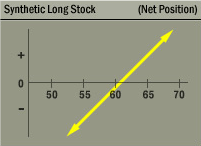Synthetic Long Stock
This strategy is essentially a long futures position on the underlying stock.
Description
The strategy combines two option positions: long a call option and short a put option with the same strike and expiration. The net result simulates a comparable long stock position's risk and reward. The principal differences are the smaller capital outlay, the time limitation imposed by the term of the options, and the absence of a stock owner's rights: voting and dividends.
If assigned, the investor who doesn't take further steps to resell, ends up with an actual long stock position. It's another reason to be wary if the long-term outlook is bearish.
Outlook
Looking for an appreciation in the stock's price during the life of the options; the sharper, the better. Since the term of the strategy is limited, the stock's longer-term outlook isn't as critical. However, if the investor is bearish on the stock's longer-term future, it would require a careful pinpointing of the trends; when the stock will head up, and when it will go down. The difficulty of making such a precise forecast suggests that this would not be an optimal strategy for a bearish investor.

EXAMPLE
- Long 1 60 call
- Short 1 60 put
MAXIMUM GAIN
- Unlimited
MAXIMUM LOSS
- Strike price - debit paid (substantial)
Summary
This strategy is essentially a long futures position on the underlying stock. The long call and the short put combined simulate a long stock position. The net result entails the same risk/reward profile, though only for the term of the option: unlimited potential for appreciation, and large (though limited) risk should the underlying stock fall in value.
Motivation
Establish a long stock position without actually buying stock.
Variations
If the strike prices of the two options are the same, this strategy is a synthetic long stock. If the call has a higher strike, it is sometimes known as a collar or risk reversal. The term collar can be confusing, because it applies to up to three strategies. Depending on which option is long and which is short, collars can mimic either a long stock or a short stock position; the term applies to both. And because the synthetic short stock version is used is so commonly as a hedge on a stock position, the three-part strategy sometimes known as protective collar is also called 'collar'.
Max Loss
The maximum loss is limited but potentially substantial. The worst that can happen is for the stock to become worthless. In that case, the investor would be assigned on the put and would have to buy the stock at the strike price. The loss would be higher (lower) by the amount of the debit (credit). In this worst case scenario, the call would of course simultaneously expire worthless.
Max Gain
The maximum gain is unlimited, just as with a long stock position. The best that can happen is for the stock to rise to infinity, in which case the theoretical gain would also be infinite. The investor would exercise the call to buy the stock at the strike price and then sell the resulting stock at the new, high price. The gain would be higher (lower) by the amount of the credit (debit) when the strategy was implemented.
Profit/Loss
As with a long stock position, the potential profit is unlimited, and the potential losses are substantial. An investor can do the research on the underlying and monitor the developments, but there is no guarantee of being able to get out of the short put position if a sharp move lower occurs.
Breakeven
This strategy breaks even if, at expiration, the stock is above (below) the strike price by the amount of the debit (credit) that the investor paid (received) when the strategy was implemented.
Breakeven = strike + net debit
(Breakeven = strike - net credit)
Volatility
Volatility is usually not a major consideration when implementing this strategy, all other things being equal. Since the strategy involves being both long and short an option with the same term and strike, any change in implied volatility should roughly be offset.
Time Decay
Since the strategy involves being both long and short an option with the same strike and term, the effects of time decay will roughly offset each other.
Assignment Risk
Early assignment of the short put, while possible at any time, generally occurs if it goes deep into-the-money.
And be aware, a situation where a stock is involved in a restructuring or capitalization event, such as a merger, takeover, spin-off or special dividend, could completely upset typical expectations regarding early exercise of options on the stock.
Expiration Risk
The investor cannot know for sure whether or not assignment occurred, until the Monday after expiration.
Comments
N/A
Related Position
Comparable Position: Long Stock
Opposite Position: Synthetic Short Stock

